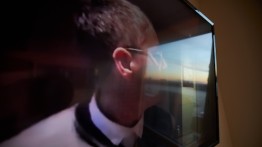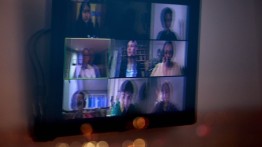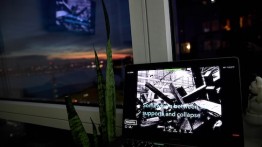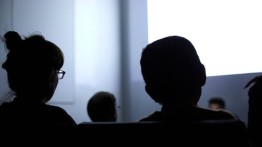Intra-Disciplinary Seminar Moves Online
POSTED ON: April 21, 2020
An essential part of an art student’s education at The Cooper Union is the Intra-Disciplinary Seminar (IDS), a course with a twenty-year history that exposes students—as well as the public—to some of the most important current voices in the arts, sciences, activism, curation, and critical theory. The roster of speakers has included Jace Clayton, Eyal Weizman, Catherine Malabou, An-My Lê, Cecilia Vicuña, Felwine Sarr and Rayyane Tabet AR'08. While the lectures are free and open to all, IDS is also a seminar course that deepens students’ relationship to research and studio practice.
For the last three years, Professors Leslie Hewitt A'00 and Omar Berrada have led and co-taught the seminar. They work with a small team of Cooper students and recent graduates who hold key positions that help promote the lectures to the public and, recently, distribute the IDS archive online. This framework has put the IDS series, which is funded by the Open Society Foundations and the Robert Lehman Foundation, in good stead for the school’s move to online classes in large part due to the creativity and ingenuity of those current students and graduates.
Professor Hewitt describes the working environment for the IDS team: “Their positions function as mentorships, a learning space that intersects with the flow of the seminars and public lectures. As a team we are all in dialogue about the ideas that the seminar will explore that year, and we explore ways that that can be communicated to a larger public through varied media platforms.”
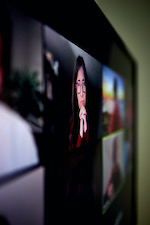
The IDS production team consists of a photographer, a social media coordinator and student liaison, and a design team. This year, as a result of all classes going virtual, two new positions have been added to the roster: post-production/AV team. On that front, Devlin Claro, 2017 graduate of the School of Art, and Isaiah Davis A'18 have been preparing pre-recorded lectures for an online audience. “Our main job is to conjoin the Keynote or Powerpoint slides with the oration prepared by that week's lecturer and ideally make the whole experience legible for a viewer,” said Mr. Claro. The work is critical, pointed out Professor Berrada, because the seminar is designed to create a sense of community for students to meet and talk with the speakers and, later, to encourage “speakers to speak to each other in the students’ minds.
This year's design team, Michelle Jimenez and Valerie Franco, developed a visual identity, which is used on the IDS web site as well as its posters and other collateral, features curling lines that slowly toggle between shades of orange and blue. Besides having to think about how the IDS visual identity will function on different platforms, the student designers need to be attuned to the overarching goals of the course, one of which is to reach and build an audience and expand the Cooper community.
Braden Hollis, a senior in the School of Art and since 2017, student liaison and coordinator for IDS’s social media, has found that, since her job is accomplished digitally, little has changed in her position. Over her three-year tenure, she has found that not only has she gained experience she has enjoyed having close access to the extraordinary speakers who have been guests in the seminar. Last fall’s lecture “After Genocide: Writing as Survival” delivered by the author Scholastique Mukasonga, whose entire family was killed during the Rwandan genocide of Tutsi citizens in 1994, proved to be particularly meaningful to Braden, who was struck by the speaker’s “ability to continue to live and create work as a testament to her family.”
Another aim of the seminar is demystifying the complex theories under discussion, ones organized around a subject that professors Hewitt and Berrada have chosen that circle back to students current research and studio interests. These “currents,” or themes, are relevant to contemporary discourses in multiple fields of study. During the 2019-20 season, IDS has been organized around three currents including "Expansion," which considers ways of knowing within an expanded field, including entanglements of human, animal, plant, and machine; “Counterpoint,” which studies how perception and politics interact in polyphonic ways; and “Dreamwork,” which examines the active role of imagination in strategies of resistance and survival.
A recent talk by Jack Halberstam, professor of English and Comparative Studies at Columbia University, demonstrates the relevant insights of the series' speakers. Entitled "After All: On Dereliction, Destitution and Dispossession," Professor Halberstam employed the photographs of Alvin Baltrop and Gordon Matta Clark's concept of "anarchitecture" to describe a response to late-stage capitalism that calls for resistance to order imposed by corporate, heteronormative institutions. Instead, he argued, we can find value in the multiple histories carved out by crisis and those people deemed outside a mainstream discourse.
The speakers, some of the most important public intellectuals of the day, introduce students to the complex and pressing topics underpinning contemporary art practice, so the job of photographer Argenis Apolinario, a 2003 Cooper art graduate, has proved to be a critical part of documenting the series. He makes expressive and revealing portraits of the speakers and their interactions with students.
An alumnus of the Saturday Program and Saturday Outreach, Mr. Apolinario, a Bronx native, said that art has always helped him “to deal with growing up in poverty and understanding myself and the world around me.” There’s a sense of curiosity in human behavior he certainly brings to his photography. Though the COVID-19 emergency has certainly provoked sadness and anxiety, he is an artist who is drawn to documenting individual foibles, one thing that is not in short supply right now. “I find humor in the unexpected and people are weird and unpredictable,” he says.
Mr. Apolinario credits his work for IDS as helping him pull through the current crisis, which, like many artists and freelancers, has quickly put an end to current work. He says, “Luckily Leslie and Omar were brilliant at coming up with new ways to continue IDS and I’m grateful that I’ve been a part of that process. In many ways Leslie and Omar and the Cooper community have really helped me endure this time and given me a creative outlet to focus my attention.”
In keeping with the theme of expansion, Professor Berrada has described the seminar as intended to show art as not an enclosed field within an academic or professional track, “but that participates in imagining different ways of seeing the world,” he says. Making IDS a digital seminar has in some way helped reach that goal thanks to the efforts of Mr. Apolinario and his colleagues. Mr. Claro, in fact has noticed the advantage of the seminar’s online presence not for as video editor, but as a member of the IDS audience.
“I appreciate getting to work as an editor of the recorded lectures now,” he says, “because I remember sitting in the Rose auditorium as a freshman during the live talks thinking to myself, ‘I wish I could slow some things down because I can't take notes fast enough to grasp all of this!’ And getting to watch the lecture in slow motion as an editor means I can understand them at my own pace and also extend this opportunity to the viewer.” Now with the series continuing on a digital platform, the whole IDS audience can follow Mr. Claro’s lead.
All photos by Argenis Apolinario.

